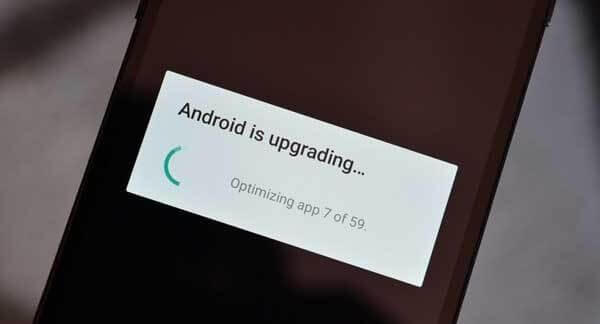How to fix the error “Android is starting to optimize the application”, which puts users in a loop or the phone may be unusable.
A step by step guide to prevent your Android phone from optimizing applications. Prevent your phone from being blocked on “Android starts …” or “Android is updating … Optimizing the application 1 of 1”.
Does your Android device behave strangely during startup? Is your phone stuck “Android starts …”? Or “Android updates …”, followed by “Optimization of the application 1 on 1”? This can be really maddening because it doesn’t seem to go away and can take hours, even if you have too many apps. If you answered “yes”, you may want to read these tips to help you resolve this problem.
But first, it is important to know the root cause of the “Optimizing App” problem on your Android device. Here are some possible reasons why this problem occurs. Knowing the root can help prevent this problem from happening again in the future.
Upgraded Android version
You may see “Android updates” after updating your Android device. When you install these updates, it clears your phone’s cache, including the files needed to run the applications available on your phone. This dialog means that your phone creates the files to allow your apps to run on the new version of Android that you just upgraded.
Inappropriate apps
Android applications must be adapted to the Android version. Most of us do not pay attention to the application when it is downloaded. However, some apps can only work on certain versions of Android.
Broken apps
Applications break during download and installation. This could be due to an incomplete or interrupted download or installation because your connection was interrupted during the download or your battery suddenly ran out during the installation of the application. The application could be broken and bring up the optimization message.
This list covers different methods to help you resolve the issue “Android starts… Optimization of the application 1 on 1 “ problem on your phone so you can start the phone and use it as you normally would.
- Unplug the device before restarting
In many cases, you will get the app optimization issue on your Android device while your device is in charge mode and restart it. So, if you restart your device and your phone is charging, it is recommended to disconnect your charger from your phone before trying to restart it. This method is fairly easy to do and will not be painful to try.
- Uninstall some apps on Android
If you notice that the problem started after installing an app, chances are this tip will fix your problem. Uninstall the app you recently installed and reinstall it from the Google Play Store.
Although this is a coincidence, it is worth solving.
If an app consumes an unusual amount of battery, uninstall it. This could help you stop optimizing apps on your Android device.
- Start the device – boot in safe mode
Starting in Safe Mode allows you to resolve issues on your Android device by temporarily blocking the execution of third-party applications. You can try restarting your device in Safe Mode in order to investigate the application optimization issue you are having on your device.
Step 1. Press and hold the power button for at least 5 seconds until the Power Menu option appears on the screen.
Step 2. Tap and hold the “Power off” button on the screen.
Step 3. A prompt to restart in safe mode should appear. Press OK.
Once your phone is in safe mode and you don’t see the app optimization issue, chances are that one of the apps installed on your device is causing the issue. You can try trick # 1 and uninstall the apps from your device to fix the problem.
- Remove the SD card from the device
If there are apps installed on your SD card, removing the SD card from your phone can help stop optimizing the app issue on your Android device.
Another quick and easy way to fix “Android starts” Error message. This is recommended in this scenario, as it helps speed up the process of optimizing looped applications and allows the phone to start up completely.
Step 1. Turn off your Android device.
Step 2. Remove your SD card.
Step 3. Turn on your device.
Step 4. Once started, reinsert your SD card.
Step 5. Move the applications installed on the SD card to the device’s internal memory.
Step 6. Update the applications installed on your device.
- Reset network settings on Android
Before trying this method, make sure you have a note of all the settings related to your network connection. This will reset all of your WiFi, Bluetooth and mobile data settings.
Step 1. Go to Settings.
Step 2. Select the Backup and reset option.
Step 3. Select Reset network settings.
Step 4. Select Reset settings and confirm.
- Optimization of application corrections (ROOT)

It is a very simple application that locks files in the cache to prevent your phone from optimizing at startup. The application developer does not promise anything. But it has worked for some and could also work for you. Remember to back up your data to avoid data loss. And once you use this application, “SET IT” before uninstalling the application to avoid the startup loop.
The application is free without advertising.
Download here
- Reset device to factory settings
This step will reset your device to the factory default settings and erase all your data, such as files and downloaded apps.
Step 1. Back up the necessary files such as photos and videos.
Step 2. Go to Settings> System> Reset.
Step 3. Click Factory Data Reset> Reset Phone.
Step 4. If prompted, enter your PIN or password.
Step 5. Delete all the data from your phone memory by clicking on “Clear data”.

